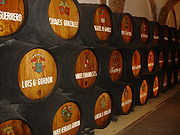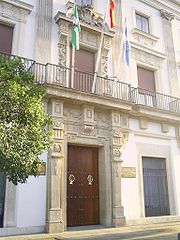
Brandy de Jerez
Encyclopedia

Brandy
Brandy is a spirit produced by distilling wine. Brandy generally contains 35%–60% alcohol by volume and is typically taken as an after-dinner drink...
that is produced only in the Jerez area of Andalusia
Andalusia
Andalusia is the most populous and the second largest in area of the autonomous communities of Spain. The Andalusian autonomous community is officially recognised as a nationality of Spain. The territory is divided into eight provinces: Huelva, Seville, Cádiz, Córdoba, Málaga, Jaén, Granada and...
, Spain
Spain
Spain , officially the Kingdom of Spain languages]] under the European Charter for Regional or Minority Languages. In each of these, Spain's official name is as follows:;;;;;;), is a country and member state of the European Union located in southwestern Europe on the Iberian Peninsula...
(exclusively produced within the "Sherry Triangle", the municipal boundaries of Jerez de la Frontera
Jerez de la Frontera
Jerez de la Frontera is a municipality in the province of Cádiz in the autonomous community of Andalusia, in southwestern Spain, situated midway between the sea and the mountains. , the city, the largest in the province, had 208,896 inhabitants; it is the fifth largest in Andalusia...
, El Puerto de Santa María
El Puerto de Santa María
El Puerto de Santa María is a municipality located on the banks of the Guadalete River in the province of Cádiz, Spain. , the city has a population of c...
and Sanlúcar de Barrameda
Sanlúcar de Barrameda
Sanlúcar de Barrameda is a city in the northwest of Cádiz province, part of the autonomous community of Andalucía in southern Spain. Sanlúcar is located on the left bank at the mouth of the Guadalquivir River opposite the Doñana National Park, 52 km from the provincial capital Cádiz and...
, in the province of Cádiz). Besides being sold as a brandy, it is also an ingredient of some sherries
Sherry
Sherry is a fortified wine made from white grapes that are grown near the town of Jerez , Spain. In Spanish, it is called vino de Jerez....
. It has a Protected Designation of Origin
Protected Geographical Status
Protected Geographical Status is a legal framework defined in European Union law to protect the names of regional foods. Protected Designation of Origin , Protected Geographical Indication and Traditional Speciality Guaranteed are distinct regimes of geographical indications within the framework...
(PDO).
History
Being unable to drink the already famous wines to be found in the Jerez region for religious reasons, the Moors opted to distil them in order to obtain “alcohol” not only to make perfumes but also for antiseptic and medicinal use. It is not easy to state the exact date upon which wine spirits began to be aged in oak-wood casks in order to produce brandy. What is clear is that in the sixteenth century there must have been an important amount of wine spirit being produced, as is illustrated by the existence of a document which makes reference to the fact that in 1580 the Town Council of Jerez handed over the revenue from the Wine Spirit Tax (a municipal tax levied on the production of wine spirit) for the construction of a Jesuit college.The eighteenth and nineteenth centuries saw the consolidation in Spain of the production of wine spirit for commercial use destined for exportation, especially to countries in Northern Europe. Holland was the main market and from there shipped on to practically the whole world.
Brandy is an English adaptation of the original Dutch word “brandewijn” (burnt wine) whilst the term holanda (name given to wine spirits of low alcoholic content used in the production of Brandy de Jerez) is obviously derived from the name of the country to which most of the exports were destined: Holland.
With these precedents is no surprise that words such as brandy and holandas originate from that country.
In any case, it should be remembered that the term 'brandavin' was already in use in picaresque literature of the 17th Century, as can be seen in “The Life and Works of Estebanillo González, man of good humour”.
In the early 19th Century English and French merchants began to arrive in Jerez who, together with Spanish traders with clear commercial instincts, promoted trade and laid down the guidelines for the characteristic production and ageing process of Brandy de Jerez.
The creation of brand names for Brandy de Jerez occurred during the 19th Century on the initiative of sherry firms who were pioneers in the sale of brands which still exist today, not only in Spain but in numerous countries throughout the world.
Production

Brandy de Jerez uses two different types of distillation
Distillation
Distillation is a method of separating mixtures based on differences in volatilities of components in a boiling liquid mixture. Distillation is a unit operation, or a physical separation process, and not a chemical reaction....
equipment, both made of copper
Copper
Copper is a chemical element with the symbol Cu and atomic number 29. It is a ductile metal with very high thermal and electrical conductivity. Pure copper is soft and malleable; an exposed surface has a reddish-orange tarnish...
:
- the traditional pot stillPot stillA pot still is a type of still used in distilling spirits such as whisky or brandy. Heat is applied directly to the pot containing the wash or wine . This is called a batch distillation ....
which in Jerez is called an alquitara – introduced by the MoorsMoorsThe description Moors has referred to several historic and modern populations of the Maghreb region who are predominately of Berber and Arab descent. They came to conquer and rule the Iberian Peninsula for nearly 800 years. At that time they were Muslim, although earlier the people had followed...
-, made of copper and heated directly by a holm-oak wood fire using a discontinuous process (loading and unloading). These are used to obtain spirits of low alcoholic content, between 40º and 70º. Holandas is the term used in Jerez to refer to these wine spirits low in alcoholic content, which are of greater quality as they require the distillation of the best of wines and better evoke the raw material from which they are produced. - distillation columns which are more modern and efficient into which the wine is introduced continuously. These columns are used in order to obtain strengths of between 70º and 94.8º.
In the case of Brandy de Jerez double distillation is not required. From a simple distillation wine spirits of 65% by volume are obtained. The more a wine is distilled, the more of its characteristics and aromatic substances are lost.
The traditional production method of Brandy de Jerez is controlled by the Consejo Regulador del Brandy de Jerez (the Brandy de Jerez Regulatory Council). The method has three main characteristics:
- The brandy must have been produced exclusively within the municipal boundaries of Jerez de la FronteraJerez de la FronteraJerez de la Frontera is a municipality in the province of Cádiz in the autonomous community of Andalusia, in southwestern Spain, situated midway between the sea and the mountains. , the city, the largest in the province, had 208,896 inhabitants; it is the fifth largest in Andalusia...
, El Puerto de Santa MaríaEl Puerto de Santa MaríaEl Puerto de Santa María is a municipality located on the banks of the Guadalete River in the province of Cádiz, Spain. , the city has a population of c...
and Sanlúcar de BarramedaSanlúcar de BarramedaSanlúcar de Barrameda is a city in the northwest of Cádiz province, part of the autonomous community of Andalucía in southern Spain. Sanlúcar is located on the left bank at the mouth of the Guadalquivir River opposite the Doñana National Park, 52 km from the provincial capital Cádiz and...
. - It must be aged in American oak casks with a capacity of 500 liters that previously contained sherry. Different types of sherry give the brandy a slightly different flavor.
- The traditional aging system of criaderas y solerasSoleraSolera is a process for aging liquids such as wine, beer, vinegar, and brandy, by fractional blending in such a way that the finished product is a mixture of ages, with the average age gradually increasing as the process continues over many years. A solera is literally the set of barrels or other...
must be used.
In Jerez it is also possible to use wine spirits of a higher degree of alcoholic content, but never (by decree of the Consejo) more than 50% of the total. The holandas must always represent 50% minimum of the final brandy.
Classification of Brandy de Jerez

- Brandy de Jerez Solera — Is the youngest and fruity, with an average age of a year and a volatile content greater than 150 mg. For every 100 cc. pure alcohol
- Brandy de Jerez Solera Reserva — With an average maturation period of three years and a total content of volatile components of 200 mg. For every 100 cc. of pure alcohol.
- Brandy de Jerez Solera Gran Reserva — Is the longer aging, with an average of ten years and a total content of volatile components of 250 mg. per 100 cc. of pure alcohol.
Tourism
"Enoturism" is a quite new kind of tourism that looks for places where wines and distilled beverages are produced. Recently the Route of Sherry Wine and Brandy de Jerez has been established.Brandy de Jerez in Spanish cuisine
Brandy de Jerez is being used in Spanish cuisine in recent years, especially with meats.External links
- Brandy de Jerez Regulating Council official site

